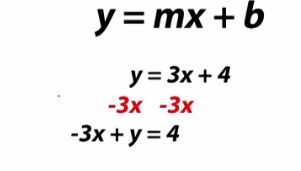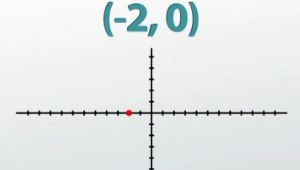Linear Equations: Intercepts, Standard Form and Graphing - Quiz
Choose your answer and write the correct one down. Then click HERE for the answers to this quiz.
NOTE: The transcript from the video is listed below the quiz for your reference.
1. Which linear equation is in standard form?
- y=2x+6
- (y-4)=2(x+6)
- x=2y-6
- y=2x-6
- 2x+3y=10
2. What are the coordinates of the x-intercept of the equation 2x-3y=8?
- (-4,0)
- (0,-8/3)
- (-8/3,0)
- (0,4)
- (4,0)
3. Which slope intercept form equation is equivalent to the standard form equation -x+2y=-8?
- y=-x-4
- y=1/2x-4
- y=-2x-8
- y=2x-8
- y=-1/2x-4
4. What is the y-intercept of the equation 5x-3y=2?
- 3-May
- 5-Mar
- -0.4
- 5-Feb
- -0.666666667
5. Which equation matches the graph below?
- -2x+y=8
- 4x+8y=1
- -4x+8y=1
- 2x+y=8
- 4x-8y=1
Do you know what to do if an equation doesn't look like y=mx+b?! If not, then this video is for you. Chances are the equation is in standard form, so we'll learn how to use standard form equations, how to graph them and why they can be helpful.
This video is on the different forms of a linear equation, specifically slope-intercept form and standard form, and how we can graph lines given to us in either of those forms. Slope-intercept form (y = mx+b) is the one that most people are familiar with. It's the most common one you see but that doesn't mean it's the only way to represent a linear equation.
 |
How to Convert to Standard Form
For example, if I had the line y = 3x+4, given to me in slope-intercept form, by using inverse operations and taking a positive 3x and undoing it with a -3x on both sides, I end up with the equation -3x+y = 4. These two equations are equivalent. They mean the same thing. They are the same thing, they're just written differently. What I end up with in this second one is what's called standard form. Essentially, because the xs and ys are on the same side of the equation. The generic standard form equation is Ax+By = C.
 |
This is probably the second most common form of a linear equation that you see, but unlike slope-intercept form, the As and Bs do not necessarily give us any useful information like the m and b does in the slope-intercept form. That doesn't mean that there aren't still some advantages to standard form over slope-intercept form.
'Slope-Intercept' Way to Graph a Linear Equation
What we're going to find out is that the orientation of the variables in standard form makes finding the x and y-intercepts pretty quick and easy, which will allow us to kind of use a shortcut when it comes to graphing.
Here we have a question that asks us to graph the line -3x+2y = 6. So let's do it the way we know how, which is by using slope-intercept form to use the m value and b value to graph our line. But because this isn't given to us in slope-intercept form, it requires us to first put it in slope-intercept form by using inverse operations to get the y by itself. This means we have to first undo the -3x with a positive 3x to both sides; we have to undo a times by 2 with a divide by 2 to both sides. Now we have the equation y = (3/2)x+3. This equation is equivalent to the one we started with, just written in a different way.
 |
Now that it's written in slope-intercept form, I know that I can use my m (my slope) and my b (my y-intercept) to graph it. I begin at 3 on the y-axis, and then I go up 3 and over 2 to find my next point using the slope. You could continue going up 3 and over 2 as many times as you wanted, but you notice that all your dots are in the same straight line. You can connect that line and you have your graph. Which isn't too bad, but these steps in the beginning that required us to first get the y by itself are unnecessary and sometimes they can be a little complicated, especially with the fractions. We'd rather know a way to do it without having to solve for y.
'Standard Form' Way to Graph a Linear Equation
So let's take a look at the exact same problem: graph -3x+2y = 6. But this time, try to do it without having to do all those beginning steps where we get y by itself using inverse operations and having to deal with fractions and all that messy stuff.
We know that at the x-intercept, y is 0, and at the y-intercept, x is 0. So because we know this, it turns out that the x and y-intercepts are really easy to find. Check it out; if I know that the x-intercept at y is 0, I can simply substitute 0 in for y into my equation, which gives me -3x+(2*0) = 6. Well, 2*0 just turns into 0, so this term just cancels out and all that we're left with are the xs, and it's a very simple, quick and easy division to both sides, because division undoes the multiplication of the -3, and we find that x = -2, which is my x-intercept. So I have the coordinates (-2,0).
 |
I can find the y-intercept in exactly the same way. This time, plugging in 0 for x, gives me the equation 2y = 6 because the xs disappear. Again, I simply undo the times by 2 and divide by 2 and I find that y = 3, which gives me the point (0,3). And I have two points and we're done. I can put those two points on my graph - (-2,0), (0,3) - and as long as you have two points, you connect them with your line, and we end up with the exact same line that we did before, but this time we didn't have to solve for y and we didn't have to deal with fractions. It was actually a little bit easier.
Lesson Summary
So to review, we've talked about slope-intercept form and also standard form. We should also probably quickly discuss the pros and cons to each.
Slope-intercept form is a little more intuitive because it gives us more information straight from the rule; it tells us the m and the b that are obvious right from the rule that I can translate quickly into information on the graph.
But standard form is nice if we're trying to find intercepts because it makes it easy to substitute in 0 and solve for the remaining value. So if you're given an equation in standard form and you're asked to graph, there's no reason you really have to change it into slope-intercept form first, and we can use this shortcut of finding the intercepts to do it without having to do all the work of solving for y.